Florida Currents

PEACE RIVER ELECTRIC COOPERATIVE SEPTEMBER 2024



Apply Today for Youth Tour 2025
Four to be chosen for Tallahassee, then narrowed to two for Washington, D.C. Page 26



















PEACE RIVER ELECTRIC COOPERATIVE SEPTEMBER 2024



Four to be chosen for Tallahassee, then narrowed to two for Washington, D.C. Page 26

















2024 • Volume 13, No. 11
CEO Michael Shepard
VICE PRESIDENT OF CONTENT Leon Espinoza
EDITORIAL DIRECTOR Mike Teegarden, CCC
DEPUTY EDITORIAL DIRECTOR
Noble Sprayberry
SENIOR EDITOR Jennifer Paton, CCC
FLORIDA CURRENTS EDITORS
Chasity Anderson, CCC; Valeri Pearon
ASSISTANT EDITORS Victoria Hampton, CCC; David Herder, CCC
ASSOCIATE EDITOR
Nina Todea
PUBLICATIONS PRODUCTION
SENIOR MANAGER
Elizabeth Beatty
SENIOR PUBLICATIONS COORDINATOR
Alyssa McDougle
Members acknowledge that $4.31 a year, plus postage, is the cost to publish 12 issues a year of FLORIDA CURRENTS ISSN 23276304 (USPS 8300). Published by Pioneer Utility Resources Inc., 5625 NE Elam Young Pkwy. Ste. 100, Hillsboro, OR 97124—a not-for-profit Oregon cooperative corporation—the magazine serves the communication needs of consumerowned electric utilities in Florida. Preferred Periodicals postage paid at Hillsboro, OR 97123 and at additional mailing offices.
Postmaster: Send address changes to 5625 NE Elam Young Pkwy., Ste. 100, Hillsboro, OR 97124-6422.
HOW TO CONTACT FLORIDA CURRENTS
Subscription services:
Nonmember subscriptions $15 U.S. a year; $25 foreign a year. Prepayment required. Allow 4-8 weeks for first issue. Identify local edition desired. Have a problem receiving your magazine? Utility members should contact their utility office. Nonmembers call 503-357-2105 or email mailingdept@pioneer.coop.
Back issues:
Back issues and extra copies are $3 each, prepayment required. Supply is limited. Identify edition, month and year. Call first to check availability. Contact Pioneer Utility Resources: P.O. Box 1306, North Plains, OR 97133-1306; 503-357-2105; email: mailingdept@pioneer.coop.
DISPLAY ADVERTISING INQUIRIES
American MainStreet Publications 611 S. Congress Ave. Ste. 504 Austin, TX 78704-1714; 800-626-1181 or 512-441-5200; amp.coop.
© 2024 Pioneer Utility Resources. All rights reserved. Reproduction in whole or in part without written permission is prohibited. Direct reprint requests to editor@floridacurrents.com or for more information, visit www.pioneer.coop.
The Environmental Protection Agency’s power plant rule threatens access to reliable electricity for millions of Americans.
The EPA’s power plant rule will:

Force the premature closure of many power plants that currently provide electricity 24/7.
Mandate the deployment of unproven carbon capture and storage technology.
Jeopardize the reliability of the grid at a time when America is already facing a surge in electricity demand.
Heighten the risk of rolling power outages to relieve pressure on the electric grid.
Increase costs for consumers as utilities are forced to pay for new power generation to comply with the EPA rule. 1 2 3 4 5
The Environmental Protection Agency released four major new regulations for the electric industry, which could disrupt domestic energy security, force always available power plants into early retirement and make new natural gas plants exceedingly difficult to permit, site and build. These rules will further strain America’s electric grid and undermine decades of work to reliably keep the lights on. For more information, visit voicesforcooperativepower.com/latest-updates.
































The eco-friendly way to get instant access to your bill and declutter your life.
















Bill due on 8/10/24 (42 days)
Updated: June 30, 2024 03:55:24 PM
Experience the convenience of paying your bill online. No more waiting for your paper bill to arrive in the mail.
Declutter your life with just a couple of clicks. The eco-friendly way to instantly access your bill.


































































































































Is a battery-powered system right for your home during an
By Scott Flood
We depend on reliable electricity more than ever before—even the briefest service interruption can be incredibly frustrating. It’s no wonder many homeowners are taking a closer look at the latest battery-powered systems as backups during an outage.
Battery technology has advanced significantly in recent years, with batteries able to hold more electricity even as they shrink in size and cost. The same innovations that boosted the performance of electric vehicles are being engineered into today’s battery-powered backup systems.
As their name implies, battery backup systems such as Tesla’s Powerwall are essentially high-capacity batteries that store electricity you can use to power your home in the event of an outage. Some are constantly charged by the power grid, and others rely on solar panels for recharging.
Traditional standby generators use small internal combustion engines fueled by natural gas, propane or diesel. They can be connected to your home’s electrical panel and kick on automatically whenever the flow of electricity stops. Assuming you keep them refueled, most can operate for days at a time.
Some standby generators can be noisy, and nearly all produce smelly exhaust containing deadly carbon monoxide gas, so they can’t be operated indoors. Large standby generators are typically installed outdoors on a concrete pad, which may detract from your home’s curb appeal.
Most home battery backups are smaller than comparable generators. Because they
don’t use combustion to generate electricity, there’s no danger of carbon monoxide exposure. That makes them safer and more environmentally friendly than generators. Most can be installed in a small space indoors. Battery backups are also significantly quieter. When a power outage occurs, battery backups start instantly, unlike generators that may take a few moments to spool up and reach operating speed. Battery backups also don’t need regular maintenance, such as oil changes or spark plug replacement, and there’s no need to store fuel.
Of course, battery-powered generators do present some disadvantages. The amount of power they deliver is limited by the capacity of their batteries. When they’re out of electricity, they may need hours of recharging before being used again, so they’re not as well-suited for lengthy outages. Energyhungry appliances, such as air conditioners and water heaters, may drain the batteries’ capacity more quickly, so you may want to disconnect them during an outage.
Fortunately, some battery backups are modular, allowing you to add capacity as needed. If you only need a few devices powered during an outage, consider a portable battery-powered system. These small, quiet backups can be used indoors to power smaller appliances, such as your laptop, TV or microwave.
Generally, batteries require long charging times. If an initial outage is quickly followed by another, they may not be able to respond. There are fast-charging systems on the market, but they carry substantially higher price tags.


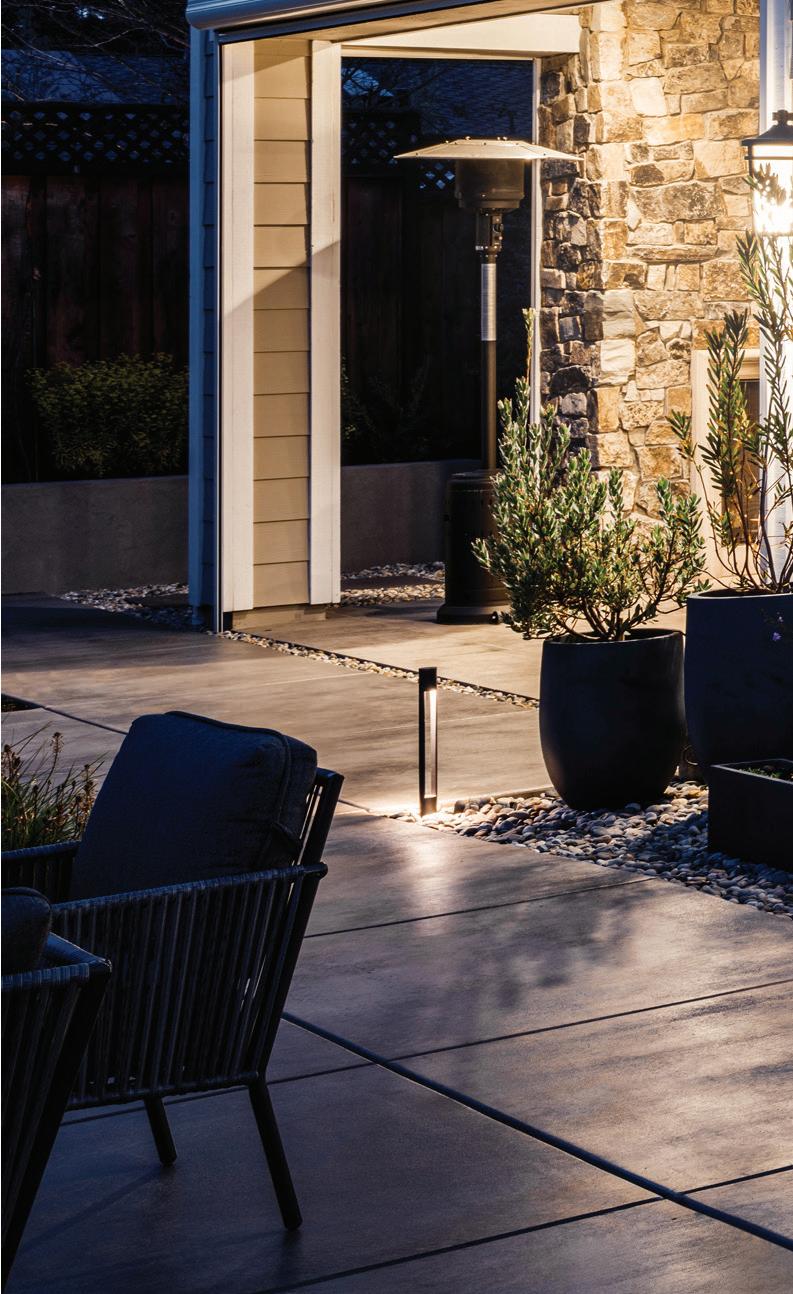

Even for a basic battery backup system, the upfront cost of a battery backup is more than a standby generator—in some cases, twice as much for comparable performance.
Like those in your mobile phones, batteries in these systems can degrade over time. In five to 10 years, they may need to be swapped out with new batteries, adding to the overall cost. Recharging battery backups with solar panels appeals to many homeowners, but the performance depends on the amount and angle of sunlight on your roof.
So, is a battery-powered backup system right for your home? The answer is different for every homeowner, but whether you’re considering a battery system or a traditional standby generator, start by calculating the amount of power you need to keep your home’s systems and conveniences operating efficiently. Once you know that,

you can determine which models are up to the task and calculate how long the device you’re considering can power your home.
If you have a family member whose health depends on devices such as a CPAP machine or supplemental oxygen, be sure to factor that into your decision.
Whether you choose a battery backup or a traditional standby generator, make sure it’s designed to protect your home and all your electronics from power surges and other issues that may damage your TVs, computers and other sensitive electronics. That way, you won’t have to worry about remaining without them long after an outage has ended.









Peace River Electric is a member-owned electric distribution cooperative. As part owner of the co-op, you have a voice in who serves on PRECO’s board of directors.
September 2024
The board of directors appoints nominating committee.
December 2024
Nominating committee selects director candidates.
February 2025
District meetings are held, and directors are elected

November 2024
Nominating committee contact information is published in FL Currents magazine. Qualified candidates should contact the committee if interested in running for a seat on the board.
January 2025
Nominations by member petition must be submitted by Jan 2. District meeting and candidate information is mailed to voters in each district.
March 2025

Newly elected directors are seated at the Annual Membership Meeting
To ensure strong local leadership, members elect directors on a rotating basis from each of PRECO’s nine districts. In 2025, terms are expiring for districts 3, 6 and 9. Your district number is printed on your electric bill. See the map below.

Terms expiring in 2025 Districts 3, 6 and 9

If you are interested in serving on the board of directors and would like more information, please contact Ashleigh Hayes at 800-282-3824 or Ashleigh.Hayes@preco.coop : . . .

Any person who meets the qualifications in the bylaws is eligible to serve as a director. For a list of director qualifications, refer to Article IV, Section 2 of the cooperative’s bylaws. Copies are available at any PRECO office or online at www.PRECO.coop/about/bylaws



bring history to life.
9-day/8-night exploration
8 ports of call with guided excursion options at each
All onboard meals and our signature evening cocktail hour
Full enrichment package with guest speakers and nightly entertainment
All tips and gratuities







Ask Keys residents where to find the best cup of coffee, and you will get multiple answers. Unlike on the mainland, most will not include traditional coffee or coffee shops, such as Starbucks. Instead, locals will recommend Cuban colada or buchi served at small mom-and-pop stores or gas stations. With names like La Niña, DeLuna’s or La Guajira, these stores typically also sell groceries, pastries and Cuban sandwiches.
One of the most recommended stops for Cuban coffee is Five Brothers,




which has locations in Ramrod Key and Key West.
Five Brothers has been a Key West fixture since the first store was opened by Cuban immigrant Heriberto Paez on Southard Street in 1978. After retiring, he realized he wasn’t ready to slow down, so he opened the second location with his two daughters in 2010.
Natalie Becker, Heriberto’s granddaughter, now owns Five Brothers Two in Ramrod Key. The store—tucked in the mangroves and palm trees off U.S. Highway 1—doesn’t look like a coffee shop from the outside. It seems more like a gas station without pumps. Once inside, however, there is no mistaking the alluring smell of strong coffee, pastries and toasting Cuban bread. The store also sells fresh seafood and Cuban specialty groceries.
Natalie is proud of her family’s Cuban roots and how the love of coffee brings diverse people together at her store.
“Our family came from Cuba,” she says. “When my grandfather immigrated, he worked two jobs to support his family and saved enough money for the first store in Key West.”
Both locations are meeting places for locals, celebrities and tourists looking to blend in.



Ironically, although coffee beans are grown in Cuba, nearly all is exported elsewhere, leaving Cubans—like Natalie’s relatives still living there—few options for the drink. Natalie says her family regularly sends coffee back to Cuban relatives.
“We send coffee and powdered milk for their coladas or café con leches,” she says. “You would be surprised how innovative the Cuban population can be when it comes to food and drink. They make the best out of a bad situation.”
Due to coffee’s scarcity and cost, many Cuban families brew a ground mixture of coffee beans and split peas—chicharo. The peas function as a cheap filler when combined with the ground coffee bean.
Cuban espresso is known for its sweetness, potency and silky texture. In the Keys, it is typically served in a Styrofoam cup with four to six small
plastic sharing glasses. The sharing concept is a strong Cuban tradition.
“Cuban coffee is all about community, togetherness and sharing,” Natalie says. “You can’t walk through the door of anyone’s house without being offered a cafecito.”

Havana restaurants are famous for images of old men sipping espresso, talking politics, playing dominos and smoking cigars.
“Sipping coladas and playing dominoes is definitely a thing for my family here and in Cuba,” Natalie says. “Teaching my husband the game and the Cuban ways has brought us closer as a family.”
Just more than 100 miles from Cuba, the Keys carries on traditions such as these thanks to the love of coffee and Cuban coffee shops.




If you were to identify the signature food or drink of the Florida Keys, Key lime pie would be high on the list, along with hogfish, Key West pink shrimp, smoked fish dip and possibly a cocktail such as the Rum Runner or the Hemingway Daiquiri. However, for a large segment of the population, Cuban espresso would be No. 1 on that list.
All along the 113 miles between Key Largo and Key West, motorists on the Overseas Highway will see signs for Cuban coffee.
What makes Cuban coffee special?
Cuban espresso is served sweet, thick and potent. In Cuba, the espresso is typically made on a stove-top pot known as a cafetera moka. While brewing, sugar—raw or white—is whipped into the espresso by hand to create a frothy and delicious foam or espumita. This makes the espresso drink thicker and more fragrant than typical espresso.
Islamorada resident and Cuban immigrant Cesar Bazan may have best described the difference between traditional coffee, served at a place like Starbucks, and Cuban espresso, served at a Keys roadside stop.
“That coffee is like beer; Cuban colada is like moonshine,” he says.




If you were to stop and experience Cuban espresso for yourself, colada, buchi and cafecito are the important menu terms used when ordering the drink. The difference is in the portion size. A colada contains between four and six espresso shots, while buchi and cafecito contain one shot. The telltale sign of Cuban espresso served at these roadside stands is the Styrofoam cup handed to customers and the four to six smaller plastic cups—known as demitasse—meant for sharing.

Brush swayed and rustled across the creek about 20 yards away as I followed a narrow trail wandering through the forest. I couldn’t quite determine the source but spotted a dark splotch moving slowly. Then, a black bear stood up to look over the brush at me.
Black bears can kill people, but they normally detect humans long before people spot them. They try to avoid humans and often disappear without anyone ever knowing they were there. I advise to give them their space.
“We have black bears all over Florida,” says Nikki Maxwell, a U.S. Forest Service spokesperson in Tallahassee. “We can’t predict what wildlife will do. It’s up to us to be aware and prepared. Behave responsibly and respectfully. Know what to do, and plan accordingly.”
Fortunately, this one ambled away on its side of the creek I planned to fish. With many other hidden waters to discover, I let the bear keep its territory.
Continuing along the trail on my side of the creek, I soon found a small pond some distance off the path. This remote pond probably saw little human activity, if any.
For wilderness adventures, I like to carry a light fishing rod kit that breaks down into several pieces and fits into a case. I can keep a few lures and other tackle in the case, which easily fits into a backpack. I assembled the rod, tossed out a lure and quickly caught several fish that probably had never seen an artificial enticement in their lives. I continued fishing but only kept what I needed for my next meal back at my campsite.
Florida offers outdoors enthusiasts vast wilderness tracts within an easy drive from anywhere in the state. The U.S. Forest Service
conserves nearly 1.2 million acres for public use in three national forests. In addition, people can visit wildlife management areas, preserves and parks to get a taste of Old Florida, the way it looked centuries ago. In these tracts, visitors can enjoy recreational experiences such as fishing, hunting, hiking, biking, camping, horseback riding, paddling, bird watching and picnicking.
As for predators other than bears, visitors might encounter rattlesnakes anywhere in Florida. In wetter areas, watch for venomous water moccasins. Practically every Florida body of water holds alligators. Usually, alligators don’t bother people, but they won’t hesitate to snatch a dog or other small pets that get too close to the water. Smaller creatures, such as ticks and mosquitoes, could also give people problems.
“Forests are nature,” Nikki says. “All kinds of wildlife will be around. Some are dangerous. Florida wildlife might be unfamiliar to people visiting or new to the state. We want everyone to have a safe and enjoyable experience.”
Before entering any forest, check the USFS website for any notices and other information: www.fs.usda.gov/main/florida.
The largest national forest in Florida spreads across four Panhandle counties from the edge of Tallahassee to Apalachicola Bay and contains two designated wilderness areas.
Hikers can wander through grassy pine savannas or visit Leon Sinks, a geologically unusual region of caverns and sinkholes surrounded by hardwoods. The Florida National Scenic Trail cuts through 74 miles of Apalachicola National Forest, and

hikers can use several other trails.
One of the largest streams in the Sunshine State, the Apalachicola River flows through the forest, providing outstanding canoeing and fishing for largemouth bass, giant catfish, crappie, bluegills and other species. The river pours off the Gulf of Mexico into Apalachicola Bay, creating a lush, brackish, marshy system. Many people fish the delta and bay for redfish, flounder, speckled trout, tarpon and many other species.
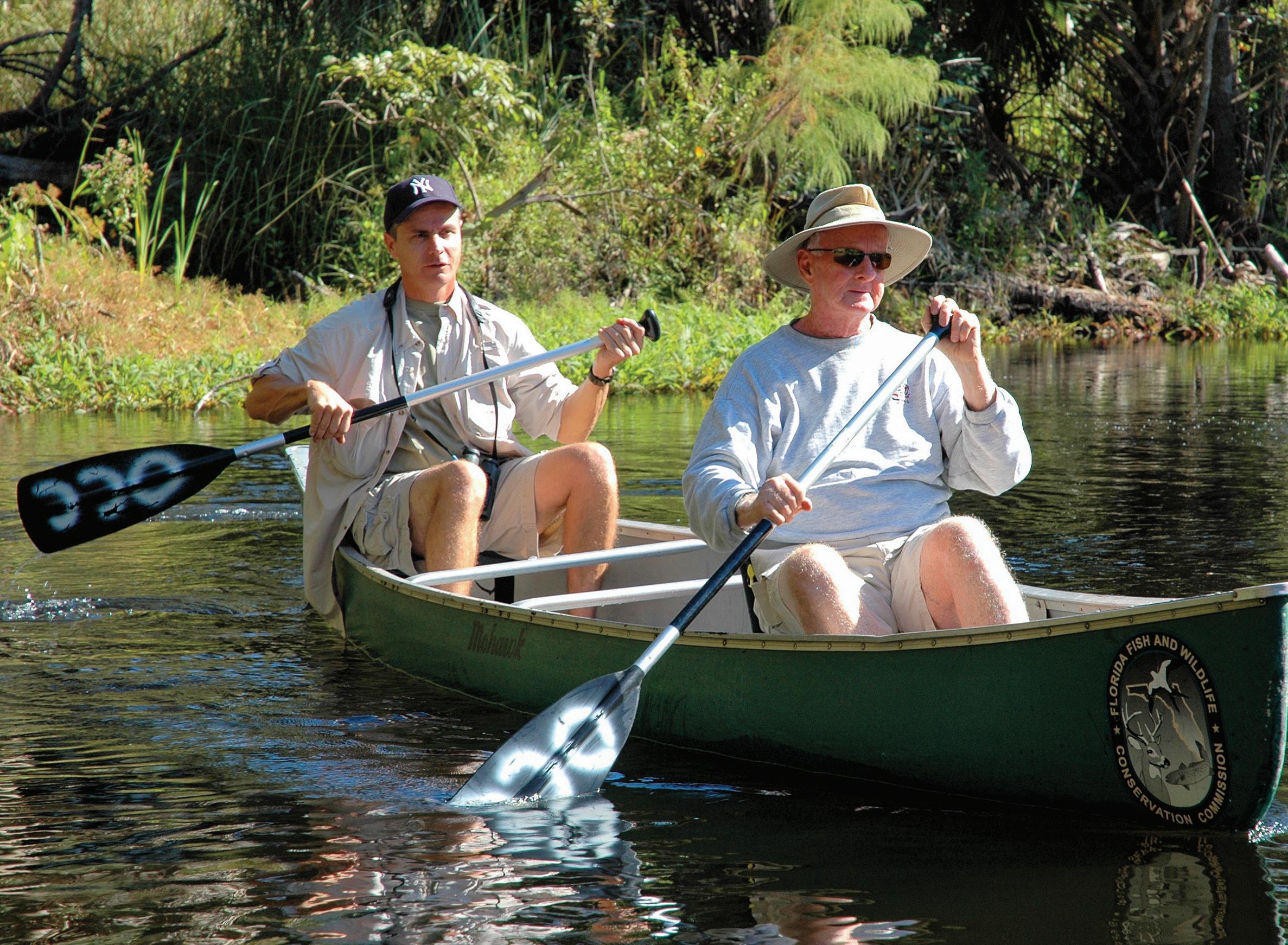
“Apalachicola Bay gets tremendous freshwater influence from the Apalachicola River and other rivers in the delta,” says Dan Van Treese with Port St. Joe’s Perfect Cast Charters. “That good mix of brackish water creates a very diverse habitat for fish.”
CLOCKWISE, FROM TOP CENTER: Florida provides a variety of habitats for many bird species. An anhinga, or snake bird, spreads its wings to dry in the sun after diving into the water to catch a fish.
Numerous streams throughout Florida provide opportunities for paddling canoes or kayaks to observe nature. With small crafts, explorers can get into places inaccessible to larger boats.
Just about every body of water in Florida contains alligators. Watch for the toothy reptiles, but leave them alone.


Ocala National Forest
Ocala National Forest spreads across Lake, Marion and Putnam counties in Central Florida. More than 600 lakes, ponds and rivers dot the forest. Halfmoon Lake and several other lakes just east of the town of Ocala offer outstanding fishing for crappie and other species.
Countless natural springs create some of the most beautiful waters in the world. Fed by Silver Springs near the town of the same name, the Silver River connects to the Ocklawaha River. Movie companies frequently shoot underwater scenes in its crystal-clear waters. Rodman Reservoir, also called Lake Ocklawaha, sits on the Ocklawaha River, about 15 miles from Palatka.
The Ocklawaha River connects to the St. Johns River system in the eastern part of the forest. Rodman Reservoir and Lake George on the St. Johns River offer fishing for giant bass, crappie and other species. Several clear streams running through this area provide excellent paddling, birdwatching and fishing. During the summer, look for manatees.
“Lake George is well known for producing big bream,” fishing guide Steve Niemoeller says. “The west side of the lake between Juniper Springs and Silver Glen Run is a good area, with lots of hard bottoms for bream bedding. Just above Juniper Springs, the Cabbage Patch is another good area. Right in front of Silver Glen Run, the water is a little deeper. That area can hold some big bream.”
Near Lake City, the Osceola National Forest spreads across Columbia, Baker, Bradford and Hamilton counties. It contains the Big Gum Swamp Wilderness. A section of the Florida National Scenic Trail cuts through the forest.
The Everglades dominates South Florida. Everglades National Park in Dade, Monroe and Collier counties covers about 20% of the total original Everglades.
The park preserves one of the largest mangrove ecosystems in the Western Hemisphere. People might also visit the nearby Big Cypress National Preserve and associated public tracts west of the Everglades.
“More than 95% of the park is designated wilderness,” says Allyson Gantt, a park spokesperson in Homestead. “We have freshwater, brackish and marine areas that give anglers many opportunities to catch different types of fish. People must take a free online boater education course before running motorboats in the park.”
Many canals, lakes and natural streams provide homes to more than 300 fish species, including many exotic species. There are peacock bass, clown knifefish, snakeheads, tilapia and more than a dozen different species of cichlids. Florida is the only place in the United States where these exotics can be caught.
“People catch many different types of fish in the Everglades


canals, especially oscars and other cichlids,” fishing guide Wayne Fellows says. “Fishing for exotics is similar to fishing for bluegill and crappie. Use crickets or live worms on small hooks under a bobber, and put the bait right next to the lily pads. Flies and beetle spinners also work well for catching exotics.”
Of course, people can still catch popular native species, such as bass, bluegills and many other bream species. Frequently, people catch largemouth, peacock bass, snakeheads and other species in the same places with the same lures.
“To catch snakeheads, use any kind of fast-moving bait that might interest largemouth bass,” Wayne says. “I’ve seen them attack spinnerbaits, plastic worms and other lures we use for bass. These exotics are far more aggressive than native fish. They fight really hard and don’t give up. Some get pretty large.”
Paddlers often venture into Marjory Stoneman Douglas Wilderness, the largest National Wilderness Preservation System unit east of the Rocky Mountains. Permits are required to camp on platforms in the wetlands.
“Many people enjoy paddling through the wilderness,” Allyson says. “We have several marked kayak trails. One of my favorites is Nine-Mile Pond. It’s a 5.2-mile loop, but there’s also a 3.6-mile loop. The loops take people through the transition between the mangroves and open marsh. The Hell’s Bay Canoe Trail leads to some camping platforms.”
At the southern end of the Everglades, Florida Bay takes up
about one-third of the park. People launch at Flamingo or in the Florida Keys to fish. Flamingo Lodge and Restaurant reopened there in 2023.
Including seasonal migrants, more than 350 bird species call the Everglades home. Birders may spot many species they won’t see in other states. Also, visitors could catch a glimpse of a Florida panther—a cougar subspecies—or American crocodiles.
“The beauty of the national park is we have wide-open spaces for animals to come and go as they please,” Allyson says. “People are visiting the animals’ homes and need to give them their space. Alligators are going to be curious or attracted to fish activity.”
Exploring Florida’s backcountry offers a unique adventure where nature’s wonders and challenges are always close at hand. From the hidden ponds of the Apalachicola National Forest to the pristine springs of Ocala and the diverse ecosystems of the Everglades, each destination provides its own slice of wilderness magic.
As you venture into these wild spaces, remember to respect the habitat of Florida’s wildlife and tread lightly to preserve these pristine landscapes for future explorers. Whether you’re fishing, hiking or simply soaking in the beauty, Florida’s backcountry is a reminder of the state’s untamed spirit. n
Visit nps.gov/ever/index.htm for information about Everglades National Park. For fishing guides all over Florida, call 888-412-1117 or visit ioutdoor.com.



Shrimp Scampi
Vegetable oil
1 tablespoon plus 1½ teaspoons kosher salt, divided
1 pound linguine
6 tablespoons unsalted butter
3 tablespoons olive oil
4 cloves garlic, minced


1 pound large shrimp, peeled and deveined
¼ teaspoon freshly ground black pepper
1⁄3 cup chopped fresh parsley leaves
½ lemon, zest grated
¼ cup freshly squeezed lemon juice
¼ lemon, thinly sliced in half-rounds
1⁄8 teaspoon red pepper flakes
Drizzle some oil in a large pot of boiling water. Add 1 tablespoon of salt and the linguine. Cook to al dente.


Meanwhile, in another large, heavy-bottomed pan, melt the butter and olive oil over mediumlow heat. Add the garlic. Saute for 1 minute. Add the shrimp, 1½ teaspoons of salt and pepper.
Saute, stirring often, until the shrimp turn pink, about 5 minutes.
Remove from the heat. Add the parsley, lemon zest, lemon juice, lemon slices and red pepper flakes. Toss to combine.
When the pasta is done, drain the cooked linguine and put it back in the pot. Immediately add the shrimp and sauce. Toss well and serve.


4 slices bacon, diced into ½-inch pieces
2 pounds jumbo shrimp, peeled and deveined
1 teaspoon Cajun seasoning
½ teaspoon salt
2 tablespoons butter
1 bunch scallions, thinly sliced, light and dark green parts divided
1 stalk celery, finely diced
Grits
4 cups whole milk
¾ teaspoon salt
1 cup quick-cooking grits
1 small red bell pepper, finely diced
2 cloves garlic, finely chopped
3 tablespoons all-purpose flour
2 cups chicken broth
1 tablespoon Worcestershire sauce
½ teaspoon hot sauce
1 cup shredded cheddar cheese
Heat a large nonstick skillet over medium heat. Add the bacon. Cook, stirring occasionally, until crisp, about 7 minutes. Add the shrimp to the skillet, and sprinkle with the Cajun seasoning and salt. Increase the heat to mediumhigh. Cook, stirring occasionally, until the shrimp are mostly pink but not quite cooked through, about 2 minutes. Transfer the shrimp and bacon mixture to a bowl, and set aside. Place the skillet back on the heat. Do not wash it.
Melt the butter in the skillet. Add the light green scallions, celery, bell pepper and garlic. Cook, stirring occasionally, until the vegetables soften, about 4 minutes. Sprinkle in the flour, and mix until incorporated. Whisk in the chicken broth, Worcestershire sauce and hot sauce. Bring to a boil. Reduce the heat and simmer, uncovered, until slightly thickened, 5 to 7 minutes. Remove the skillet from the heat. Set it aside while you make the grits. In a medium saucepan set over medium heat, bring the milk and salt to a boil. Whisking constantly, slowly pour the grits into the bubbling milk. Reduce the heat to low. Simmer, whisking often, until the grits become thick and creamy, about 5 minutes. Stir continuously to prevent sputtering.
Remove the pan from the heat, and stir in the cheese. Taste. Adjust the salt, if necessary. Remove the pan from the heat. Cover with a lid to keep warm until ready to serve. Place the skillet with the vegetable/sauce mixture back on the stove. Bring to a simmer over medium heat. Return the shrimp and bacon, along with any juices that collected in the bowl, to the skillet. Mix well. Cook, stirring frequently, until the shrimp are cooked through, 2 to 3 minutes.
Season to taste with salt and pepper. Sprinkle dark green scallions over the shrimp.
1⁄3 cup honey
¼ cup soy sauce
2 garlic cloves, minced
1 teaspoon minced fresh ginger
1 pound medium uncooked shrimp, peeled and deveined
2 teaspoons olive oil
Green onion, chopped
In a medium bowl, whisk together the honey, soy sauce, garlic and ginger to make a marinade/sauce.
Place shrimp in a large sealable container or zipped-top bag. Pour half of the marinade on top. Shake or stir, then marinate the shrimp in the refrigerator for 15 minutes or up to 12 hours. Cover and refrigerate the remaining sauce.
Heat olive oil in a skillet over medium-high heat. Place shrimp in the skillet. Discard used marinade.
Cook shrimp on one side until pink, about 45 seconds, then flip shrimp over. Pour in remaining marinade/sauce and cook it all until shrimp is cooked through, about 1-2 more minutes.
Serve shrimp with cooked marinade sauce. Garnish with green onions.
1 tablespoon vegetable oil
1 small yellow onion, thinly sliced
1⁄3 cup thinly sliced scallions, white and green parts
2 cloves garlic, minced
2½ tablespoons Thai green curry paste
14-ounce can coconut milk
¼ cup water
2 tablespoons fish sauce
1 tablespoon light brown sugar
2 pounds jumbo shrimp, peeled and deveined
2 tablespoons lime juice
Lime wedges for serving ¼ cup chopped fresh cilantro
Heat the oil in a large skillet over medium-high heat. Add the onions. Cook, stirring frequently, until soft, about 3 minutes.
Add the scallions, garlic and green curry paste. Cook, stirring frequently, for 2 minutes.
Add the coconut milk, water, fish sauce and sugar. Bring to a gentle boil. Add the shrimp. Cook, stirring frequently, until the shrimp are pink and just cooked through, 3 to 4 minutes.
Stir in the lime juice, and sprinkle with the cilantro. Taste and adjust seasoning, if necessary. Serve with jasmine rice.
By Dave LaBelle
I remember photographing an elderly man leaning on a hoe while working in his garden. Watching him through a telephoto lens, I was curious what he was thinking. I may have asked him, but I don’t remember. Later, as I looked at the photograph, I wondered what his life had been like.
What were his dreams or regrets?
Then a year or so later, I was assigned to photograph a philosopher who was in town to speak. He was staying at a luxurious inn. Arriving early, as is my habit, I noticed a man walking slowly down a tree-lined driveway, his hands behind his back. Unnoticed, I stopped and

made a few photographs before approaching him.
I asked him about his morning stroll.
“I take long walks alone,” he answered. “I ask intelligent questions and get intelligent answers.” Then he added, “But my best thoughts usually come to me when I am on the toilet and have nothing else to do.”
Fifty-five years later, I see myself in the posture of both aging men. Either image could be a self-portrait of sorts, of me contemplating life now.
I have often seen glimpses of myself in others, for good and bad. In a quiet, subtle way, I think I have photographed others to express what I was experiencing. In telling their story, I was telling my own. Someone once wrote and said they had watched my daily newspaper photos for years and felt they knew me. I hadn’t thought much about that before, but reasoned there was some truth in their observation. No doubt those who follow this column or read my blog can say with some accuracy, they know me. The subjects I choose, the personal things I share— they are doors into my life and heart. I feel the same about some authors or sports announcers.
There was a period in my young life when I felt alone and hopeless. I photographed
Make a picture that expresses where you are in your life’s journey. Maybe it is something that reveals what you believe or how you see yourself? Or perhaps, like me, it’s something or someone you aspire to be like. This is a tough assignment but one worth trying.
Email your best image (just one, please) with caption information, including an explanation of how it affects you, to GPH@pur.coop. We may share submissions on our website and social media channels.
many sad and lonely people, transients and those who had lost loved ones. I think I was crying in my camera, silently asking for help through my photographs.
I believe most of us ask ourselves why we are here on this earth and what plan or purpose we serve. Now, at 73, I have come to realize one of the talents my creator has blessed me with is the gift to give others a voice while serving as a mirror to show others themselves, especially their beauty and value.

Renowned author, photographer and lecturer Dave LaBelle has captured special moments for more than half a century. For more of his writings, visit davidlabelle.com and bridgesandangels.wordpress.com.









































































































People don’t always do what their doctor says, but when seasoned veteran emergency room physician, Dr. Philip B. Howren, says every senior should have a medical alert device, you better listen up.
“Seniors are just one fall away from being put in a nursing home,” Dr. Howren said. “With a medical alert device, seniors are never alone. So it keeps them living independently in their own home. That’s why seniors and their family members are snapping up a sleek new medical alert device that comes with no monthly bills ever,” he said.
Many seniors refuse to wear old style help buttons because they make them look old. But even worse, those medical alert systems come with
monthly bills.
To solve these problems Universal Physicians, a U.S. company went to work to develop a new, modern, state-ofthe-art medical alert device. It’s called “FastHelp™” and it instantly connects you to free unlimited nationwide help everywhere cell service is available with no contracts, no deposits and no monthly bills ever.
“This slick new little device is designed to look like the pagers doctors wear every day. Seniors love them because it actually makes them look important, not old,” Dr. Howren said.
FastHelp is expected to hit store shelves later this year. But special newspaper promotional giveaways are slated for seniors in select areas. ■

■ NO MONTHLY BILLS: “My wife had an old style help button that came with hefty bills every month and she was embarrassed to wear it because it made her look old,” said Frank McDonald, Canton, Ohio. “Now, we both have FastHelp™, the sleek new medical alert device that our grandkids say makes us look ‘cool’ not old,” he said. With FastHelp, seniors never have to worry about being alone and the best part is there are no monthly bills ever.
The phone lines are ringing off the hook.
That’s because for seniors born before 1956, it’s a deal too good to pass up.
Starting at precisely 8:30am this morning the PreStore Release begins for the sleek new medical alert device that comes with the exclusive FastHelp™ One-Touch E 911 Button that instantly connects you to unlimited nationwide help everywhere cell service is available with no contracts, no deposits and no monthly bills ever.
“It’s not like old style monitored help buttons that make you talk to a call center and only work when you’re at home and come with hefty bills every month. FastHelp comes with state-of-the-art cellular embedded technology. That means it works at home or anywhere, anytime cell service is available
(Continued on next page)

whether you’re out watering the garden, driving in a car, at church or even hundreds of miles away on a tour or at a casino. You are never alone. With just a single push of the One-Touch E Button you instantly get connected to free unlimited help nationwide with no monthly bills ever,” said Jack Lawrence, Executive Director of Product Development for U.S. based Universal Physicians.
“We’ve never seen anything like it. Consumers absolutely love the sleek new modern design and most of all, the instant rebate that practically pays for it and no monthly bills ever,” Lawrence said.
FastHelp is the sleek new medical alert device with the best of combinations: a quality, high-tech engineered device that’s also an extremely great value because there are no monthly bills ever.
Better still, it comes with no contracts, no deposits and no monthly bills ever – which makes FastHelp a great choice for seniors, students and professionals because it connects to one of the largest nationwide networks everywhere cell service is available for free.
And here’s the best part. All those who already have an old style monitored medical alert button can immediately eliminate those monthly bills, which is why Universal Physicians is widely advertising this announcement nationwide.
“So if you’ve ever felt a medical alert device was too complicated or expensive, you’ll want to get FastHelp, the sleek new medical alert device with no monthly bills,” said Lawrence.
The medical alert device slugfest was dominated by two main combatants who both offer old style monitored help buttons that come with a hefty bill every month. But now Universal Physicians, the U.S. based heavyweight, just delivered a knockout blow sending the top rated contenders to the mat with the unveiling of FastHelp. It’s the sleek new cellular embedded medical alert device that cuts out the middleman by instantly connecting
you directly to highly trained 911 operators all across the U.S. There’s absolutely nothing to hook-up or install. You don’t need a land line and you don’t need a cell phone. Everything is done for you.
“FastHelp is a state of the art medical alert device designed to make you look important, not old. Old style monitored help buttons you wear around your neck, or
require expensive base station equipment or a landline are the equivalent of a horse and buggy,” Lawrence says. “It’s just outdated.”
Millions of seniors fall every year and spend hours lying on the floor helpless and all alone with no help.
But seniors who fall and get immediate help are much more likely to avoid getting sent to a nursing home and

get to STAY living in their own home independently.
Yet millions of seniors are still risking their safety by not having a medical alert device. That’s because seniors just can’t afford to pay the monthly bills that come with old style medical alert devices.
That’s why seniors born before 1956 are rushing to cash in the whopping $150
instant rebate before the 21 day deadline ends.
So there’s no need to wait for FastHelp to hit store shelves later this year because seniors born before 1956 can get it now just by using the $150 instant rebate coupon printed in today’s newspaper before the 21 day deadline ends. If lines are busy keep trying, all calls will be answered. ■
You cannot use the rebate coupon below and must pay $299 Call: 1-800-330-9423 DEPT. HELP8313
THE BOTTOM LINE: You don’t need to shop around. We’ve done all the leg work, this deal is too good to pass up. FastHelp with the instant rebate is a real steal at just $149 and shipping and there are no monthly bills ever.
PROS: It’s the sleek new medical alert device that comes with the exclusive FastHelp OneTouch E 911 Button that instantly connects you to free unlimited nationwide help everywhere cell service is available with no contracts or deposits. It connects you to the vast available network of cellular towers for free and saves seniors a ton of money because there are no monthly bills ever making this deal irresistible. Plus it’s the only medical alert device that makes seniors look important, not old.
CONS: Consumers can’t get FastHelp in stores until later this year. That’s why it’s so important for seniors born before 1956 to call the National Rebate Center Hotline within the next 21 days. For those who miss that deadline, the sleek little medical alert device will set you back over $300 bucks.






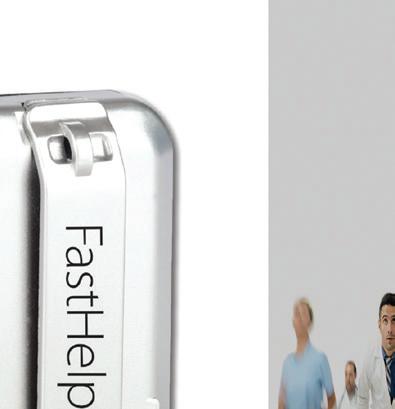







All ages can find something new and exciting around every corner of the state. Filled with rich history, abundant natural beauty and diverse events all year, Florida has something fun for everyone.
Now through Sept. 20
Members Market Art Exhibit


Sept. 1
Summer Guided Tours

Free and open to the public, this exhibit features local artists. The Joe is a community art center dedicated to supporting the arts and providing opportunities for artists and art lovers along the Forgotten Coast. thejoecenterforthearts41.wildapricot.org
Aug. 31 to Sept. 1
Florida Scallop, Music and Arts Festival
Featuring the best arts and crafts vendors from the region and incredible food vendors, the family-friendly festival offers arts, crafts, live music, food and more. A one-day pass is $10 in advance or $15 at the gate. A two-day pass is $20 in advance. Children 12 and younger get in free. bit.ly/3Rco6YQ; 350-227-1223


In honor of Labor Day weekend, the History of Diving Museum offers guided tours at 11 a.m. and 2 p.m. Find out the interesting stories behind all the exhibits. Tours are included in the price of admission—$15 for adults, $13 for seniors, $7 for children ages 6-11 and free for children ages 5 and younger. The museum is located at mile marker 82.9 bayside. divingmuseum.org; 305-664-9737
Sept. 1
Gentle Yoga with Manatees
Join the fun at The Bishop for views of the manatees being cared for in the Parker Manatee Rehabilitation Habitat while engaging in yoga poses focused on balance, flexibility and strength. Bring your yoga mat. Discovery Society members’ fee is $15, and nonmember fee is $20. Proceeds support the rehabilitation and return of manatees to the wild. Advance registration is required. Ages 7 and older are welcome. bishopscience.org/yoga; 941-746-4131
Sept. 7
License-Free Freshwater Fishing Day
License-free fishing days allow those who don’t yet have a fishing license to experience the sport, to take youth fishing or for avid anglers to introduce a friend to fishing without having to buy a license. On these days, the fishing license requirement is waived for all recreational anglers—residents and nonresidents. All other rules—such as seasons, bag and size limits—apply. www.myfwc.com; 850-488-4676


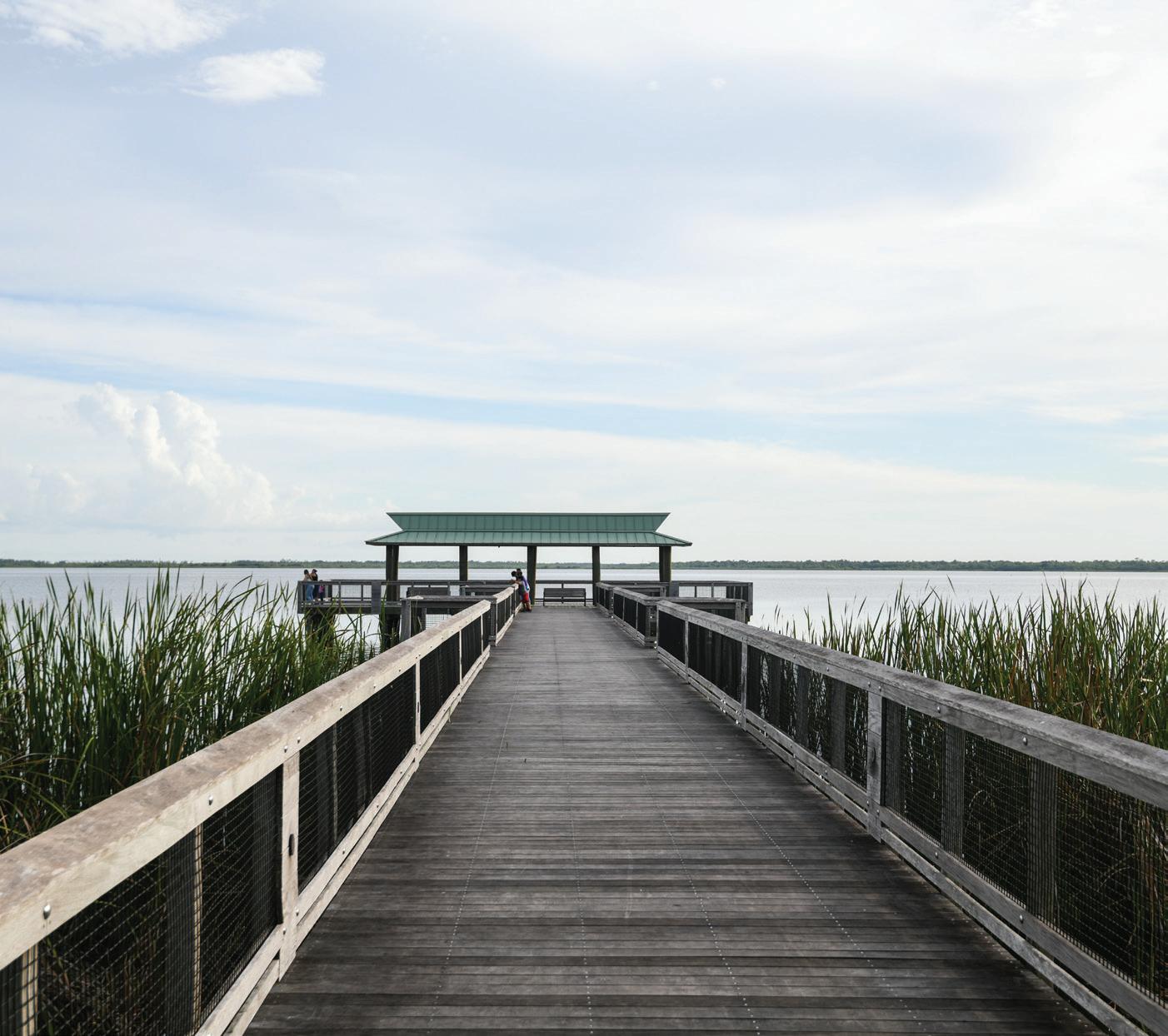



Sept. 7, 21
Salt Air Farmers Market
Treat your family to art pieces and fresh veggies, sweet tupelo honey, and vine-ripened fruit from local farmers and artisans. The market is open 9 a.m. to 1 p.m. on the first and third Saturdays. www.saltairmarket.com; 404-906-2637
Sept. 14
Rock4Vets



The Rock4Vets 5K Run/Walk is an annual event that combines fitness, music and fun to raise funds and awareness for local homeless veterans. Participants can run or walk a 5K course and then enjoy live music performances, food, drinks and games in a vibrant festival atmosphere. choosepeoples.com/rock4vets; 850-378-5618
Sept. 14
Kids Day at Gulfarium Marine Adventure Park
Join Daniel Tiger and Clifford the Big Red Dog for some PBS KIDS fun at Gulfarium Marine Adventure Park. Along with character meet-and-greets, children can engage in hands-on activities, including arts and crafts, a scavenger hunt, the park’s dolphin and sea lion shows, animal exhibits and aquariums. The park is open during regular business hours, and a portion of the day’s admission fees will be donated to the WSRE-TV Foundation. www.gulfarium.com; 850-484-1200



Sept. 7
Swim for Alligator Lighthouse
Swimmers have up to seven hours to complete the 8-mile roundtrip course out and back around Alligator Reef Lighthouse, ranked as one of the toughest swimming challenges in the world. The course features an in-water start and a beach finish, ending shoreside during this tropical open-water event. The competition raises funds for the restoration of the 151-year-old Alligator Reef Lighthouse. www.swimalligatorlight.com
Sept. 19
Third Thursday Art Walk
During the Morada Way Arts and Cultural District’s landmark monthly event, Keys-inspired fine artists, vendors, residents and visitors congregate from 6-9 p.m. on Morada Way to celebrate the arts and culture in the Florida Keys. Enjoy perusing local fine art, imbibing local craft beer and wine, and listening to music—in the area between mile markers 81 and 82. www.moradaway.org; 305-664-2471
Sept. 19
Ducks Unlimited Banquet
Join us from 6-10 p.m. for an evening of conservation at the fifth annual Blackwater DU Banquet and Fundraiser at Sowell Farms. Ducks Unlimited is a 501(c)(3) nonprofit tax-exempt organization that is the world leader in wetlands and waterfowl conservation. There will be a barbecue dinner with live auctions, silent auctions and raffles. Tickets are $85 per person, and sponsor and corporate tables are also available online.
bit.ly/3Yv5qrN; 833-273-8438

Sept. 28
Fall Festival and Market
Bring the family from 10 a.m. to 2 p.m. to Aaron Bessant Park for a free event. Enjoy fall fun, crafts, music, food and handmade items. Enjoy live music 11 a.m. to 1 p.m. The first 300 visitors will get a complimentary tote bag upon arrival.
bit.ly/3SA5Jhd; 350-233-5045



Want to share a family-friendly event with the readers of Florida Currents? Head online and enter the details at tinyurl.com/FloridaCurrents. Make sure to submit the item at least 60 days before the event (due to press deadline). If you own rights to a print-quality photo promoting your event, include it with photo credit information.


FREE MATERIALS
SOON Church/Government uniting, suppressing RELIGIOUS LIBERTY enforcing NATIONAL SUNDAY LAW. Be informed! TBSM, PO Box 374, Ellijay, GA 30540. tbsmads@yahoo.com 1-888-211-1715



The Journey Air Elite features the latest carbon fiber technology for the ultimate in portability and performance
Mobility issues affect over 1 in 5 Americans. These individuals, and their loved ones, know how decreased mobility can result in loss of independence, pain and falling hazards. They are often stuck at home, missing out on a variety of activities, in a vicious cycle that diminishes their quality of life. In the past, mobility devices like scooters and power chairs were too heavy and bulky to transport easily. Now, carbon fiber material invented for the aerospace program has been used to create the ultimate mobility device. It’s called the Journey Air Elite … and there’s nothing else like it on earth.
At only 26 pounds*, the Journey Air Elite combines lightweight portability with world class performance. It’s simple to use joystick and powerful dual-motor drive system enables you to zip around quickly and safely. It’s easy to maneuver, never tips, fits easily through doorways, and can go right up to a table or desk. Once you are done, just one pull on the seat handle folds it up. There’s a fold-down back to make it even easier to stow and store. It features flatfree tires and rear anti-tippers for added convenience and safety.









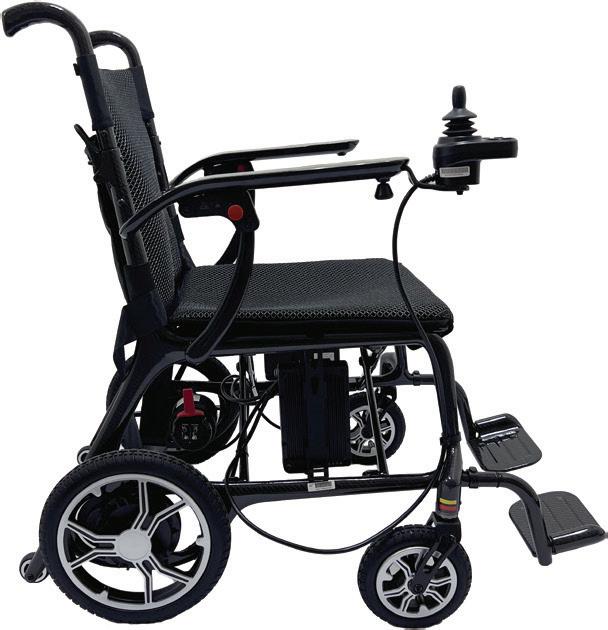
•Speedy
•Comfortable
•Pulls
•8-mile
•Perfect

Just imagine how this chair can improve your life and make it easier for loved ones and caregivers to accompany you to activities and events you would have missed in the past. Don’t spend another day stuck at home. Call today, and a helpful, knowledgeable consultant will help you get a Journey Air Elite of your very own. Don’t wait –call now!
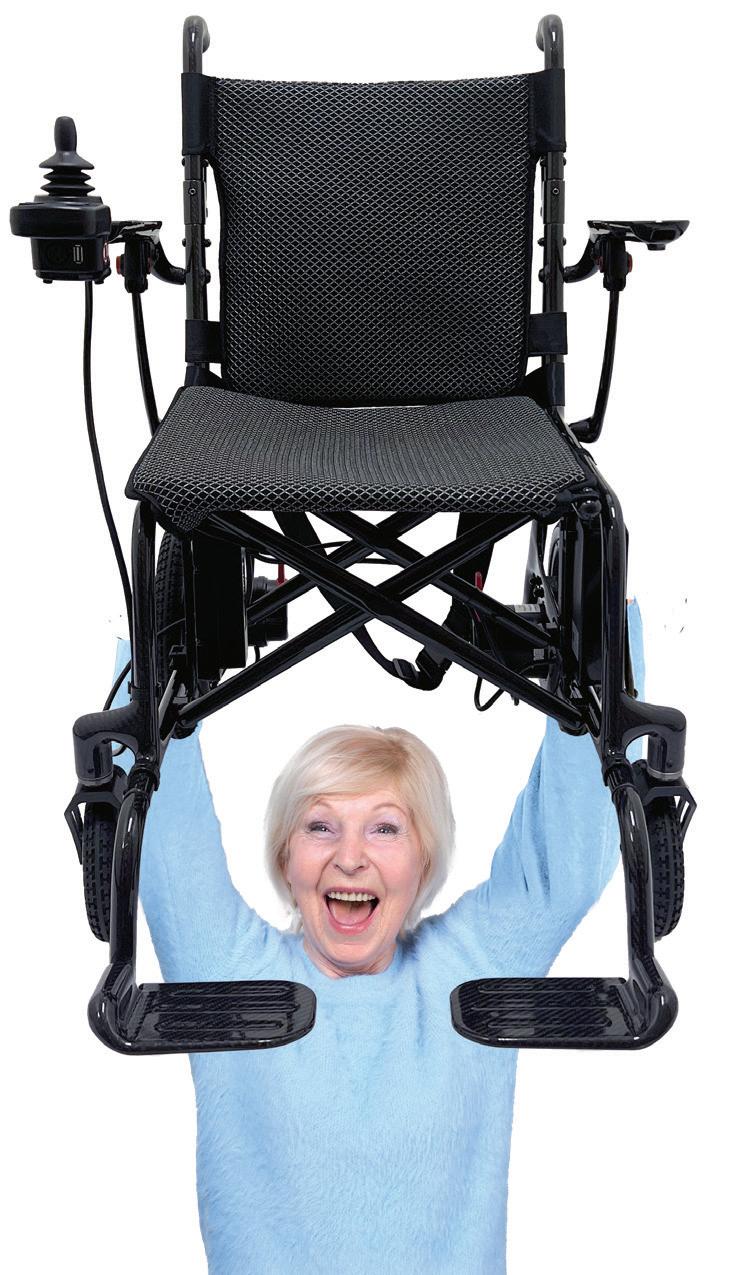








CLOCKWISE FROM TOP: Students in the Tara Elementary Art Club use an Apple iPad and Apple pencil to paint digitally in apps like Sketchbook and ProCreate. Gifted teacher Lisa Boyer, from Manatee County Schools, was able to purchase games that allow all abilities to play together. These games allow the students to build social skills and learn the fine art of graceful winning and graceful losing. Students at Sun ’N Lake Elementary practice reading note names, rhythms and proper playing techniques on MIDI keyboards used in their music class.
At Peace River Electric Cooperative, we believe in the power of education and the importance of fostering creativity and innovation in the classroom. That's why we're excited to announce our Operation Round Up Teacher Mini-Grant program, designed to support educators in bringing their innovative project ideas to life.
Since 2021, PRECO’s Operation Round Up charitable foundation has granted more than $35,500 to 87 area classrooms through our Teacher Mini-Grant program.
What is the Teacher Mini-Grant?
The Teacher Mini-Grant is an initiative that provides financial assistance to teachers who are dedicated to enhancing the learning experience for their students. Whether it's a unique science experiment, an interactive art project or a cutting-edge technology integration, we want to help make your vision a reality.
Who Can Apply?
All teachers within our service area are eligible to apply for the mini-grant. We encourage educators from pre-K to high school and all subject areas to submit their creative and impactful project ideas.
Complete an online application at PRECO.coop/teacher-mini-grants.






















Peace River Electric Cooperative is looking for students to serve as delegates for the 2025 Youth Tour. Four student representatives are sponsored for a visit to Tallahassee for a two-day, overnight conference Feb. 12-13, 2025. Students learn about the cooperative business model and Florida’s legislative process. The Youth Tour includes a visit to the House of Representatives’ chambers and a session in the Supreme Court. During this experience, two students are chosen to represent PRECO at the National Rural Electric Cooperative Association Youth Tour in Washington, D.C., next June 16-21. The Washington, D.C., trip includes visits to the Lincoln Memorial, Arlington National Cemetery, Mount Vernon, Vietnam Veterans Memorial and many more historic sites, alongside hundreds of other students from across the nation.

Students must be enrolled as a junior in a local high school.
Students must have an immediate family member who is a PRECO member.
Interested students should complete and submit the following:

1. Youth Tour application at PRECO.coop.
2. Minimum 500-word essay that explains, “What makes you a good candidate to represent PRECO on the Youth Tour, and what do you wish to gain from this experience?”
3.

A letter of recommendation from a high school counselor, teacher or administrator.

Completed online application, essay and letter of recommendation must be received by PRECO no later than 5 p.m. Friday, Dec. 6.

Students selected for the Youth Tour are notified in early January 2025. Washington, D.C., Youth Tour representatives are chosen in February.








While many hunters complain of too much pressure on overcrowded public tracts, Florida outdoorsmen can hunt abundant game with virtually no pressure even on public lands.
Florida hunters can shoot common gallinules from Sept. 1 to Nov. 9 with a daily limit of 15 per person.
Common gallinules look similar to coots with gray to charcoalcolored feathers. Their most striking feature, a chicken-like bright orange bill tinged in yellow, distinguishes them from coots and other waterfowl. Scarlet patches on their foreheads make excellent field marks.
People might see another gallinule species in Florida, but don’t shoot it. Not legal game in Florida, purple gallinules exhibit blue and green feathers, purple heads, long yellow legs, white rumps and red bills with yellow tips. Bright blue forehead patches distinguish purple gallinules—or blue peters—from their common cousins.
Gallinules live in marshes and other areas with thick grasses, such as along the St. Johns River. They inhabit grassy lake or river shorelines and other wetlands where high vegetation grows next to the waterline.
Gallinules prefer to hide in the grass rather than fly to escape danger and frequently use their long toes to deftly walk across grass mats, lily pads or other vegetation.
To stalk gallinules, hunters can walk the marshes flushing birds, but another method is in a kayak or canoe. Federal law prohibits anyone from shooting at migratory birds from boats under motor or sail power until the motor shuts off and all forward momentum
ceases. This includes electric motors. However, people can paddle, drift or pole boats while legally shooting migratory birds.
Hunting in a canoe is one way to introduce youths to the sport. Position the young shooter in the bow while the adult paddles and acts as spotter. The youth can sit in relative comfort. On a good day, hunters might see hundreds of birds and fire quite a few times. In addition, paddlers can carry food, refreshments, and other supplies or equipment to take occasional breaks.
Since gallinules receive very little pressure, hunters can regularly paddle fairly close to them without spooking them. Some birds remain motionless in thick grass even if the boat passes within a few feet of them.
If birds disappear into the reeds, they might reemerge a short time later if they think the danger passed. If not, remember that spot and return to it later.
When hunting gallinules, there’s no need to arrive before dawn. The birds often stay out all day. Since waterfowl fly best at first light, hunters could combine a teal or duck hunt with a gallinule hunt during the season. After hunting waterfowl at first light, spend the rest of the day paddling up gallinules.
You can even cast fishing rods while leisurely paddling and watching for birds.
Shooting a limit of gallinules could turn a humdrum morning into an exciting adventure, especially for a young or novice hunter.

John N. Felsher is a freelance writer, broadcaster, photographer and editor. An avid sportsman, he’s written more than 3,500 articles for more than 170 different magazines on a wide variety of outdoor topics. He also hosts an outdoor tips show for WAVH-FM Talk 106.5 in Mobile, Alabama. Contact him at j.felsher@hotmail.com or through Facebook.






This summer, two exceptional local students embarked on a memorable journey as part of the Washington, D.C., Youth Tour sponsored by NRECA. These students, joined by 1,657 young leaders representing 44 states, gathered to explore the heart of American history, government and culture.
Jennifer Gonzalez-Delacruz and Gracyn Thomas experienced the nation’s capital in a way few others get to. Youth Tour

aims to inspire and educate the next generation of leaders about the importance of civic engagement and the role of electric cooperatives in supporting their communities.
The itinerary was packed with exciting activities and educational experiences. The students started their tour with a visit to the National Air and Space Museum and the Vietnam Veterans Memorial. It was Father’s Day, so many loved ones had paid

tribute with roses along the wall.
Another stop was Arlington National Cemetery, where delegates visited Audie Murphy’s gravesite, where they learned he was World War II’s most decorated American combat soldier.
The group also embarked on a scenic riverboat cruise down the Potomac River, taking in the breathtaking views of Washington, D.C. The cruise offered a unique perspective of the city and a chance



CLOCKWISE FROM ABOVE: Roses were placed along the Vietnam Veterans Memorial on Father’s Day to honor those who made the ultimate sacrifice. Gracyn Thomas, right, and Jennifer Gonzalez-Delacruz visited the Thomas Jefferson Memorial, Mount Vernon and the Washington National Cathedral.
to unwind while soaking up the history and beauty of the nation’s capital.
Another first for many on the trip was attending a baseball game. Students enjoyed the vibrant atmosphere of a live sporting event, which provided a perfect blend of relaxation and fellowship among the delegates.
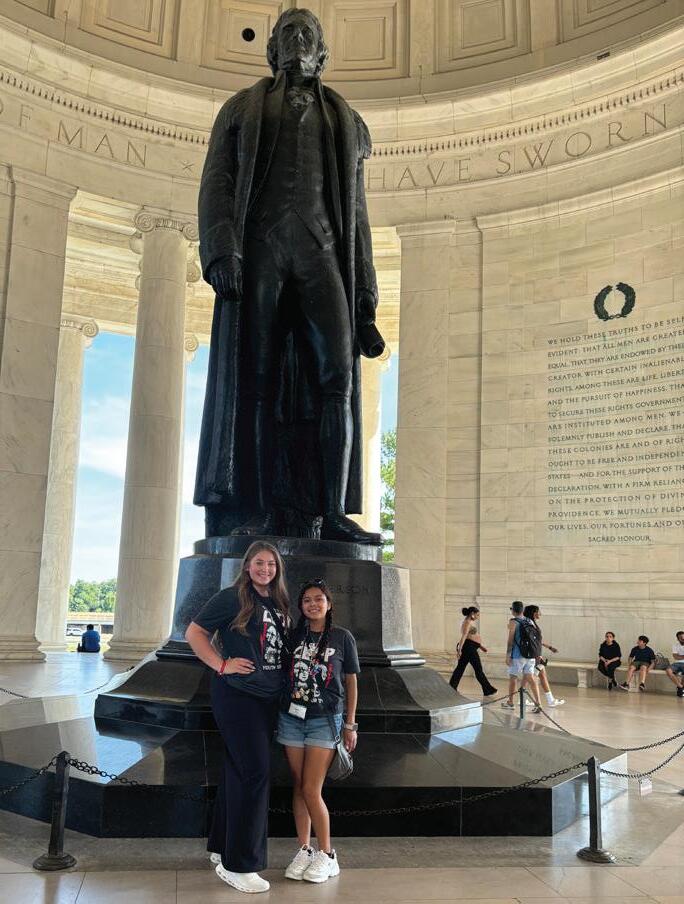

A trip to Washington, D.C., isn’t complete without touring some of the most significant landmarks, monuments and memorials. Students visited the U.S. Capitol, the White House, the Franklin D. Roosevelt Memorial, the Martin Luther King Jr. Memorial, the Korean War Veterans Memorial, the Lincoln Memorial, the Library of Congress, the Iwo Jima Memorial, Mount Vernon, the Washington National Cathedral and so much more.

Among the most touching experiences was the visit to the 9/11 Pentagon Memorial and the Holocaust Museum. These visits gave the students profound insights into the tragedies and triumphs that have shaped modern history. At the 9/11 Memorial, the students paid their respects to the victims and heroes of that fateful day. At the same time, the Holocaust Museum offered a solemn reminder of the past and the importance of tolerance and human rights.


Jennifer Gonzalez-Delacruz
“I enjoyed every single second of the trip, but my absolute favorite part of the trip was learning the history behind every single monument that was created. My overall sentiment of the trip was: Never take anything or anyone for granted.”

Gracyn Thomas
As the weeklong trip came to a close, the students returned home with a wealth of knowledge, new friendships and unforgettable memories. The Youth Tour to Washington, D.C., was not just an educational journey but a life-changing experience inspiring these young leaders for years to come.



“Over the course of the week, I made memories that will genuinely last a lifetime. I never would have imagined being surrounded by such amazing, like-minded people who were also given the opportunity to represent their cooperatives and learn more about the NRECA. When it comes to picking my favorite sights of the week, I don’t think I could narrow it down to just two because, after all, we were able to visit the National Air and Space Museum, the Holocaust Museum, Mouth Vernon, the Capitol Building and so much more. All of these experiences were so special to me not only because of my personal interest but also because I could put into perspective what I’ve always been taught about our country and our history and see it firsthand. I loved getting to have dinner on a river cruise and dance the night away with my new friends, and even catch a Washington Nationals baseball game. All in all, I can confidently say I’m honored to have had the opportunity to represent Peace River Electric Cooperative and learn more about the amazing impact that cooperatives and NRECA have on families, homes and communities to keep the lights on.”






































































PRECO.coop
800-282-3824
TO REPORT A POWER OUTAGE
Use the SmartHub app.
Text OUT to 800-282-3824.
Call 800-282-3824.
CORPORATE HEADQUARTERS
210 Metheny Road
Wauchula, FL 33873
MANATEE SERVICE CENTER
14505 Arbor Green Trail
Lakewood Ranch, FL 34202
BOARD OF DIRECTORS
District 1
LEONARD CRAWLEY
District 2
KENNETH ODEN
District 3
BRUCE VICKERS
District 4
HOLLIS ALBRITTON
District 5
MARIE DASHER
District 6
VACANT
District 7
CHRIS PORTALE
District 8
ELLEN BACHMAN
District 9
WILLIE DAWES
BOARD MEETINGS
September 24
October 22
November 19
Any PRECO member may attend board meetings. Due to building security requirements and to facilitate attendance, members should contact the cooperative in a timely manner for logistical information regarding meetings.

PRECO business offices are closed for Labor Day, Monday, Sept. 2.

At Peace River Electric Cooperative, keeping the lights on at a cost you can afford is the focal point of everything we do. Transparency is one of our core values, so in addition to sharing our successes, we have a responsibility to tell you about the challenges we face.
In May, the U.S. Environmental Protection Agency issued a rule that impacts energy production from power plants. The rule constrains existing coal and new natural gas plants by requiring them to install carbon capture and storage—a technology that has potential but is unproven.
No power plant in North America uses CCS at the scale and levels mandated by EPA. Furthermore, it is not practical for this technology to be developed, scaled and deployed in time to meet the arbitrary timelines in these new regulations.
When power plants aren’t able to comply with EPA’s CCS requirements, they are required to shut down, significantly limit operations or switch fuels. These unrealistic standards force the unnecessary and early shutdown of many power plants that provide reliable electricity 24/7. The power plant rule undoubtedly threatens access to reliable electricity for our local community and communities across the country.
Renewable sources are important components of our overall generation mix. PRECO is working with our wholesale power supplier, Seminole Electric Cooperative, to exponentially grow our portfolio of solar power. However, given its intermittent nature, we cannot depend solely on solar energy because the sun does not always shine. The need for always-available powergenerating resources is essential.
The timing of the power plant rule is equally troubling. At the same time EPA is leading our nation down the path to fewer power plants, utilities are facing a surge in electric demand, driven by the onshoring of manufacturing, the growth of the American economy and the rapid expansion of data centers to support artificial
intelligence, e-commerce and cryptocurrency.
Many states have already experienced rolling outages. If EPA’s power plant rule further threatens the supply of electricity, the problem will only get worse. In fact, the North American Electric Reliability Corp., the nation’s electric reliability watchdog, recently forecast that over the next five years, all or parts of 19 states are at high risk of rolling power outages during normal peak electricity demand conditions.
It is no secret that costs go up when demand is high and supply is low. We are concerned about threats to the affordability of your electric services as well as its reliability.
At PRECO, we are concerned about the environment, and we are proud of the achievements we have made. This year, carbon emissions from Seminole Electric Cooperative’s power plants have decreased by approximately 40% compared to their 2005 carbon emission levels. We are not casting a blind eye toward the environment. But, these new standards go too far, too fast and threaten the reliability of the electric grid.
I don’t say all of this to worry you, but I want our members to understand the challenges ahead. We are working to reduce our carbon footprint in a manner that does not sacrifice the reliability of your electric service.
Electric cooperatives like PRECO deliver power to 42 million Americans. Our priority is meeting our members’ energy needs, and we must have reliable power generation available.
We are joining electric co-ops across the country to challenge these regulations, and we are working with our local elected officials to help them understand the consequences this could have on all Floridians.
If you are interested in learning more about policy impacts on power reliability or in making your voice heard on this matter, visit voicesforcooperativepower.com.
